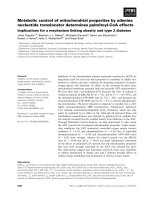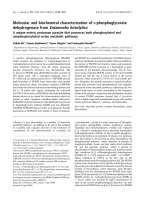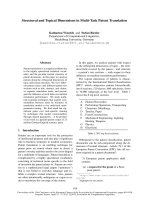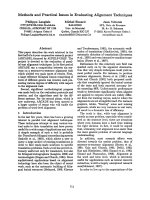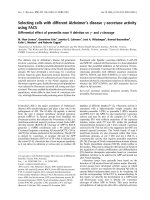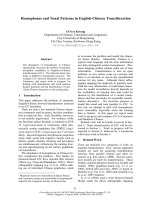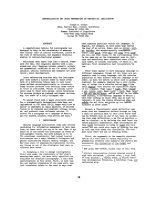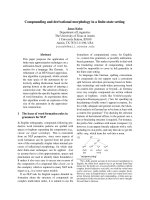Báo cáo khoa học: "Metabolic and endocrine profiles and reproductive parameters in dairy cows under grazing conditions: effect of polymorphisms in somatotropic axis genes" doc
Bạn đang xem bản rút gọn của tài liệu. Xem và tải ngay bản đầy đủ của tài liệu tại đây (361.68 KB, 10 trang )
RESEARCH Open Access
Metabolic and endocrine profiles and
reproductive parameters in dairy cows under
grazing conditions: effect of polymorphisms in
somatotropic axis genes
Gretel Ruprechter
1*
, Mariana Carriquiry
1
, Juan Manuel Ramos
2
, Isabel Pereira
1
and Meikle Ana
1
Abstract
Background: The present study hypothesized that GH-AluI and IGF-I-SnabI polymorphisms do change the
metabolic/endocrine profiles in Holstein cows during the transition period, which in turn are associated with
productive and reproductive parameters.
Methods: Holstein cows (Farm 1, primiparous cows, n = 110, and Farm 2, multiparous cows, n = 76) under grazing
conditions were selected and GH and IGF-I genotypes were determined. Blood samples for metabolic/endocrine
determinations were taken during the transition period and early lactation in both farms. Data was analyzed by
farm using a repeated measures analyses including GH and IGF-I genotypes, days and interactions as fixed ef fects,
sire and cow as random effects and calving date as covariate.
Results and Discussion: Frequencies of GH and IGF-I alleles were L:0.84, V:0.16 and A:0.60, B:0.40, respectively. The
GH genotype was not associated with productive or reproductive variabl es, but interaction with days affected FCM
yield in multiparous (farm 2) cows (LL yielded more than LV cows) in early lactation. The GH genotype affected
NEFA and IGF-I concentrations in farm 1 (LV had higher NEFA and lower IGF-I than LL cows) suggesting a better
energy status of LL cows.
There was no effect of IGF-I genotype on productive variables, but a trend was found for FCM in farm 2 (AB cows
yielded more than AA cows). IGF-I genotype affected calving first service interval in farm 1, and the interaction
with days tended to affect FCM yield (AB cows had a shorter interval and yielded more FCM than BB cows). IGF-I
genotype affected BHB, NEFA, and insulin concentrations in farm 1: primiparous BB cows had lower NEFA and BHB
and higher insulin concentrations. In farm 2, there was no effect of IGF-I genotype, but there was an interaction
with days on IGF-I concentration, suggesting a greater uncoupling somatropic axis in AB and BB than AA cows,
being in accordance with greater FCM yield in AB cows.
Conclusion: The GH and IGF-I genotype s had no substantial effect on productive parameters, although IGF-I
genotype affected calving-first service interval in primiparous cows. Besides, these genotypes may modify the
endocrine/metabol ic profiles of the transition dairy cow under grazing conditions.
* Correspondence:
1
Faculty of Veterinary Medicine and Agronomy Sciences, University of
Uruguay, Montevideo, Uruguay
Full list of author information is available at the end of the article
Ruprechter et al. Acta Veterinaria Scandinavica 2011, 53:35
/>© 2011 Ruprechter et al; licensee BioM ed Central Ltd. This is an Open Access article distributed under the terms of the Creative
Commons Attribution License ( nses/by/2.0), which perm its unrestricted use, distribution, and
reproduction in any medium, provided the original wor k is properly cited.
Background
Energy balance of dairy cows becomes negative (NEB)
during the transition period due to increased nutrient
requirements that typically exceed dietary intakes. With
the onset of lactation, plasma levels of non-esterified
fatty acids (NEFA) and B-hidroxybutyrate (BHB)
increase markedly, according to the magnitude of adi-
pose tissue mobilization, to prov ide additional energy
for maintenance and milk production [1-3]. Growth
hormone (GH) is known to be responsible for galact o-
poiesis and persistency of lactation [1,4], and the
uncoupled somatotropic axis (GH-insulin-like growth
factor I axis, IGF-I) mediates nutrient partitioning for
lactogenesis in high producing dairy cows [5]. Concen-
trations of GH are usually increased during early post-
partum and its metabolic effects are antagonistic to
insulin by enhancing lipolysis in t he adipose t issue and
gluconeogenesis in the liver [1,6,7]. Thus, insu lin resis-
tance develops to help direct nutrients from insulin-sen-
sitive tissues to the lactating mammary gland [1].
Indeed, genetically-selected dairy cows had increased
GH and reduced IGF-I and insulin concentrations dur-
ing early lactation [8]. Since IGF-I a nd insulin affect
ovarian function, low concentrations of these hormones
during the postpartum period are associated with pro-
longed acyclicity [9-13]. As GH has proven to play a key
role on the regulation of metabolism and milk produc-
tion by m odulating the expression of many genes,
including IGF-I [14,15], these two genes - GH and IGF-
I - could be considered candidate gene markers for pro-
ductive and reproductive traits.
A polymorphic site of the GH gene that results in an
amino acid change at position 127 - leucine, (L) to
valine, (V) - detected by AluI, has been linked to milk
production traits [16]. However, research results have
been controversial as several authors [17-20], reported
increased production traits associated with the L allele,
while others [21-23] determined a favorable effect of the
V allele on production. In contrast, Yao et al. [24] were
not able to prove any association between this poly-
morphism and production traits. Very few studies have
been performed regarding the relationship between GH-
AluI genotype and reproduction [25-27]. Lechnniak et
al. [25] reported that homozygous VV beef bulls tended
to present greater non-return rates suggesting a benefi-
cial effect on reproduction whereas no effect of this
polymorphism was found on number and diameter of
oocytes collec ted [26]. Balogh et al. [27] did not find an
effect of this polymorphism on days to first postpartum
ovulation in dairy cows.
A polymorphic site in the first promoter region of the
bovine IGF-I gene was found by Ge et al. [28]. This
polymorphism was identified as a point mutation, T
(allele A) to C (allele B) transition, also referred to
SnaBI by the same author. Unlike the abundant reports
found in relation to GH-AluI genotype, scarce reports
exist regarding the relationship between milk production
and the IGF-I-SnabI genotype. Siadkowska et al. [29]
determined that Polish Holstein-Friesian cows carrying
the AB genotype yielded more daily fat-corrected-milk
(FCM) than those of AA and BB genotypes, while Hines
et al. [30] found no association between IGF-I-SnabI
genotype and production traits in Holstein cattle. In
addition, the BB genotype has been associated with
greater body weight at weaning in commercial beef lines
of Bos taurus [31] and greater growth rates in Holstein-
Friesian bulls [29]. We have not found reports of IGF-I
polymorphism and bovine reproduction.
Few studies performed in different bo vine breeds and
physiological stages focused on the mechanism by which
these GH or IGF-I genotypes affect metabolic and endo-
crine profiles [32,28,33,34]. Only one report on the
mentioned GH and IGF-I polymorphisms in dairy cow
during the transition period was found. Balogh et al.
[33] could not demonstrate any effect of GH-AluI geno-
type on BHB, insulin, IGF-I, and leptin concentrations
in one blood sample collected between 4 and 13 days
postpartum in Holstein Friesian dairy cows.
The present study hypothesized that GH-AluI and
IGF-I-SnabI genotypes do change the metabolic and
endocrine profiles in Holstein cows during the transition
period, which in turn may be associated with t he pro-
ductive and reproductive responses.
Materials and methods
Animals and experimental design
Holstein cows under grazing conditions from two com-
mercial dairy herds in Uruguay were used. All proce-
dures were carried out in accordance with regulations of
the Animal Experimentation Committee (Veterinary
Faculty, University of Uruguay, Uruguay). Blood samples
collected by coccygeal venopunction into tubes Vacutai-
ner
®
(Becton Dickinson, NJ, USA) conta in ing K3EDTA
were used to determine GH and IGF-I genotypes. Preli-
minary data of milk production and composition
according to these GH and IGF-I genotype has been
published before [35].
Farm 1
Primiparous Holstein cows that ca lved between March
and May were randoml y selected (n = 11 0) from a 700-
cow herd. All cows grazed a mixture of ryegrass (Lolium
multiflorum) in the morning and alfalfa (Medicago
sativa) in the afternoon and were supplemented with 12
kg dry matter (DM) of corn silage, 5 kg DM of high-
moisture corn grain, and 2 kg DM sunflower meal. The
diet offered had 17% crude protein and 1.7 Mcal/kg DM
of net energy of lactation (NRC, 2001). Cows w ere
milked twice daily and milk yield and composition (fat
Ruprechter et al. Acta Veterinaria Scandinavica 2011, 53:35
/>Page 2 of 10
and protein) were measured once monthly until the end
of lactation. Body condition score (BCS) was determined
at -7 ± 4, and exactly at 30 and 60 days postpartum
(dpp) using a 5- point scale [36]. At the same time,
blood samples for metabolites and hormones analyses
were collected by coccygeal venopunction into hepari-
nized tubes from 94 cows, centrifuged at 3000 Xg for 20
min and plasma was stored frozen ( -20°C) until further
analysis. The breeding period consisted of 4 months
from June to September. Oestrus was detected twice a
day and cows were artificially inseminated (AI), 12
hours after heat detection by the same inseminator.
Pregnancy diagnosis was perfo rmed by rectal palpation
45 days after AI.
Farm 2
Multiparous Holstein cows (n = 60) that calved b etween
September and November were randomly selected from
450-cow herd; cows had 1 (L2, n = 36) or 2 (L3, n = 24)
previous lactations. During the last month before cal-
ving, cows grazed on a native pasture and received 11
kg DM/cow/ day of a diet composed of 7 kg DM of sor-
ghum silage, 3 kg DM of sorghum grain, 1 kg DM of
sunflower meal (36% crude protein) and 100 g of urea.
After calving, cows received a commercial mineral sup-
plement and were managed under a rotational grazing
system with supplementary feed added to maintain a
pasture forage availability of 1,200 kg DM and an esti-
mated total intake of 18 kg DM/cow/day. The diet
offered had 17% crude protein and 1.5 Mcal/kg DM of
net energy of lactation (NRC, 2001). Cows were milked
twice daily and milk yield and composition (fat and pro-
tein) were measured once weekly for the first month of
lactation and afterwards monthly until the end of lacta-
tion. Cow BCS was determined every 15 days from -30
to 60 dpp a s described for farm 1. Blood samples for
metabolites and hormones analyses were collected from
29 cows as described in farm 1 every 15 days from -30
dpp to calving, and then once a week up to 60 dpp. The
breeding period consisted in 3 months from September
to November: during the first two months AI was used,
insemination 12 hours after oestrus detection t wice a
day, and natural mating was used during the last month.
Pregnancy diagnosis was performed as described in farm
1.
Laboratory analysis
Genotyping of GH and IGF-I and hormone (insulin and
IGF-I) analyses were performed at the Nuclear Techni-
ques Laboratory (Veterinary Faculty, University of Uru-
guay, Uruguay), while metabolites analyses (NEFA and
BHB) were performed at DILAVE Laboratory ( Pando,
Uruguay).
Extraction of DNA was performed according to Kawa-
saki [37] and DNA was s tored frozen ( -20°C) until
further analysis. The GH-AluI genotype was deter mined
by a polymerase chain reaction-restriction fragment
length polymorphism (PCR-RFLP) according to Lucy et
al. [18]. Primers designed to amplify a 428-bp sequence
of the bovine GH gene, GH For.: 5’-CCGTGTCTATGA-
GAAGC-3’ and GH Rev.: 5’-TTCTTGAGCAGCGCGT-
3’were used. A Digestion of PCR product was performed
with 6U of AluI (Fermentas Inc., MD, USA) restriction
endonuclease. Fragments of DNA were resolved in a 2%
agarose gel stained with ethidium bromide (EtBr) and
fragments of either leucine (L; 265, 96, 51 and 16 bp) or
valine (V; 265, 147 and 16 bp) alleles were visualized
under UV light (Cleaver Scientific, England).
The IGF-I-SnabI g enotype was determined by PCR-
RFLP according to Ge et al, [28]. Primers designed to
amplify a 249-bp sequence of the bovine IGF-I gene,
IGF-I For.: 5`-ATTACAAAGCTGCCTGCCCC-3` and
IGF-I Rev.: 5`-ACCTTACCCGTATGAAAGGAATA-
TACGT-3`were used and PCR products digestion was
performed with 5U of SnabI (Fementas Inc., MD, USA)
restriction endonuclease. The DNA fragments were
reso lved in a 3% agarose gel staine d with EtBr and frag-
ments of either T (A) (223 and 26 bp) or C (B) (undi-
gested, 249 bp) alleles were visualized under UV light
(Cleaver Scientific, England).
Plasma insulin concentrations were determined by a
125
I-Insulin RIA kit (Diagnostic Products Co., Los
Angeles, California, USA). The assay sensitivity was 1.3
μIU/mL and the intra-assay and inter-assay coefficients
of variation were less than 8.2 and 10.1% for control 1
(4.2 μIU/mL) and 9.4 and 11.3% for control 2 (12.6
μIU/mL), respectively. Pl asma IGF-I concentrations
were determined by the IGF1 RIACT (Cis Bio Interna-
tional, GIF SUR YVETTE CEDEX, France). The assay
sensitivity was 16 ng/mL and th e intra-assay coefficient
of variation were 3.4 and 5.8% for control 1 (50.4 ng/
mL) and 16 and 17% for control 2 (709 ng/mL),
respectively.
Plasma NEFA and BHB concentrations were assayed
by spectrophotometry using commercial kits: Kat. #FA
115 kit (Wako Chemicals, Richmond, VA, USA) and
Kat. #RB 1007 (Randox Laboratories Ltd, Ardmore, UK),
respectively. The intra-and inter-assay coefficient of var-
iations for both metabolites were less than 7.3 and 9.7%,
respectively.
Statistical analyses
Data were analyzed in a complete randomized design by
farm using the SAS program (Statistical Analysis Sys-
tem; SAS Institute Inc., Cary, NC, USA). Univariate ana-
lyses were performed on all variables to identify outliers
and inconsistencies and to verify normal ity of residuals.
Production traits and h ormone and metabolite concen-
trations were analyzed by repeated measures using the
Ruprechter et al. Acta Veterinaria Scandinavica 2011, 53:35
/>Page 3 of 10
MIXED procedure with days as the repeated effect and
first-order autoregressive (for evenly spaced data ) or
spatial power law (for unevenly spaced data) as the cov-
ariance structure. The Kenward-Rogers procedure was
used to adjust the denominator degree of freedom. The
model included GH and IGF-I genotypes, dpp, and
interactions as fixed effects, and sire and cow as random
effects and calving date as covariate. Interactions
remained in the model if P < 0.10. Pearson’s linear cor-
relation was estimated between predicted and observed
data to evaluate model adjustment. Reproductive traits
(calving-first service interval, number of services per
conception and total pregnancy rate) were analyzed with
a generalized linear mode l (GENMOD procedure) with
a Poisson distribut ion and log transformation (calv ing-
first service interval) or a binomial distribution and logit
transformatio n (pregnancy rate). The model included
the effect of GH and IGF-I genotypes as fixed effects
and calvi ng dat e as a covariate. Results are expre ssed as
lsmeans (LSM) ± SE. For all results, means were consid-
ered to differ when P ≤ 0.05 and trends were identified
when 0.05 < P < 0.10.
Results
A c2 test showed that allele frequency and genotypes of
GH and IGF-I were in Hardy-Weinberg equilibrium (P
= 0.97) and did not differ between farms (P > 0.28). GH
allele frequencies were L (0.84) and V (0.16), while IGF-
I allele distribution were A (0.60) and B (0.40). The
number of cows f or each genotype was LL (n = 122),
LV (n = 51) and VV (n = 4) for GH genotypes and AA
(n = 63), AB (n = 98) and BB (n = 25) for IGF-I geno-
types. Due to th e unequal distribution of GH genotyp es
in our study (dominance of the L allele and low fre-
quency of V allele) we exclude VV genotype from
further analysis.
Productive and reproductive responses
Correlations between predicted and observed values for
all productive and reproductive variables were between
0.47 and 0.81. The GH genotype was not assoc iated
with productive variables in either of the farms (Tables
1 and 2, Figure 1A and 1B). While no effect of the inter-
action between GH genotype and dpp on productive
variables was observed in farm 1 (primiparous cows), a
trend was observed on 4%FCM yield (P = 0.07) in farm
2 (multiparous cows), as LL cows presented greater
FCM y ield than LV cows during early lactation (15 and
75 dpp, Figure 1B). The GH genotype had no effect on
reproductive variables in none of the farms studied
(Tables 1 and 2).
The IGF-I genotype had no effect on the productive
variables in farm 1 (Tables 1 and 3), but a trend for an
effect o f the interaction of IGF-I genotype a nd dpp was
observed in 4%FCM yield (P = 0.09), as AB cows yielded
more FCM than BB cows at 120 and 210 dpp (Figure
1C). In farm 2, IGF-I genotype tended (P = 0.09) to
affect FCM yield (Table 1) as AB cows had greater FCM
yield than AA cows (P = 0.03), while no differences
were found between AB and BB cows. Fat-corrected-
milk yield was numerically greater for BB than AA cows
(21.9 vs. 19.7 ± 1.05 kg/d) b ut this difference did not
reach significance (P = 0.16) (Table 3, Figure 1D).
The IGF-I genotype had a significant effect on calving-
first service interval only in farm 1 ( Table 1), as AB
cows had a shorter interval than BB cows (Table 3). No
Table 1 F-tests of fixed effects included in the model for
productive/reproductive parameters and metabolic/
endocrine variables and BCS of Holstein cows under
grazing conditions in two commercial farms.
Farm 1 Farm 2
GH IGF-I dpp GH IGF-I dpp
Milk (L) 0.43 0.25 < 0.01 0.41 0.18 < 0.01
FCM (L) 0.54 0.24 < 0.01 0.56 0.09 < 0.01
Total solids (kg) 0.50 0.23 < 0.01 0.44 0.13 < 0.01
Calving 1
st
service (days) 0.26 < 0.01 - 0.23 0.17 -
Service/conception 0.74 0.68 - 0.45 0.90 -
Pregnancy rates 0.97 0.96 - 0.80 0.97 -
BCS 0.42 0.58 0.86 0.42 0.95 < 0.01
BHB (mmol/L) 0.31 0.01 0.09 0.86 0.77 < 0.01
NEFA (mmol/L) 0.01 < 0.01 0.06 0.77 0.44 < 0.01
Insulin (μUI/mL) 0.99 0.02 < 0.01 0.53 0.91 < 0.01
IGF-I (ng/mL) 0.09 0.34 < 0.01 0.85 0.95 < 0.01
Fixed effects are GH and IGF-I genotype and days post partum (dpp)
Table 2 Productive/reproductive parameters and
metabolic/endocrine variables (LSM ± SE) for GH
genotypes of Holstein cows in two commercial farms
Farm 1 Farm 2
GH genotype GH genotype
LL LV SE LL LV SE
Milk (L) 17.9 17.5 0.50 23.1 22.1 0.80
FCM (L) 15.9 15.5 0.45 21.6 21.0 0.91
Total solids (kg) 1.14 1.11 0.03 1.60 1.54 0.06
Calving 1
st
service (days) 88 86 9 79 83 4
Service/conception 2.3 2.2 0.2 1.3 1.6 0.1
Pregnancy rates 80 78 7 72 64 10
NEFA (mmol/L) 0.39
a
0.41
b
0.02 0.34 0.33 0.03
BHB (mmol/L) 0.25 0.26 0.01 0.63 0.60 0.06
Insulin (μUI/mL) 3.5 3.5 0.23 2.60 2.81 0.38
IGF-I (ng/mL) 98.5
x
79.4
y
7.45 113.64 113.92 11.14
BCS 2.9 2.7 0.2 3.04 3.00 0.04
ab
Values marked with different letters are significantly different at P < 0.05
xy
Values marked with different letters are a trend at P < 0.10
Ruprechter et al. Acta Veterinaria Scandinavica 2011, 53:35
/>Page 4 of 10
other effect of IGF-I genotype was observed on repro-
ductive variables (Table 3).
Metabolic and endocrine profiles
In farm 1, the GH genotype affected or tended (P =
0.09) to affect plasma NEFA and IGF-I concentrations,
respectively, but did not affect BCS or any other meta-
bolic parameters (Table 1, Figure 2 A-H). Cows carrying
LV genotype had greater plasma NEFA and tended to
present lower IGF-I concentrations than LL cows (Table
2). Although plasma IGF-I conc entrations decreased (P
< 0.01) after calving in both genotypes, LV cows pre-
sented lower IGF-I concentrations at 30 and 60 dpp (P
< 0.02) than LL cows (Figure 2G). In farm 2, GH
genotype did not affect BCS or any of the endocrine/
metabolic profiles (Table 1).
The IGF-I genotype affected BHB, NEFA, and insulin
concentrations in farm 1 (Table 1) as BB cows presented
lower plasma NEFA and BHB and greater insulin con-
centrations than AA and AB cows (Table 3, Figure 3 A,
C, E). While insulin concentrations declined (P < 0.01)
from -7 to 30 and 60 d pp for AA and AB cows, plasma
insulin was maintained during the study in BB cows;
being insulin concentrations at 30 dpp greater in BB
than AA and AB cows (P < 0.01) (Figure 3 E). In farm
2, the interaction between IGF-I genotype and dpp
tended (P = 0.06) to affect IGF-I concentrations as AA
cows tended (P < 0.07) to present lower prepartum IGF-
A
FCM (L)
Da
y
s (0=calvin
g
)
B
D
Da
y
s (0=calvin
g
)
#
8
12
16
20
24
28
0 60 120 180 240
8
12
16
20
24
28
0 60 120 180 240
LV
LL
Farm 1
Farm
2
FCM (L)
8
12
16
20
24
28
0 60 120 180 240
C
AA AB BB
8
12
16
20
24
28
0 60 120 180 240
#
#
*
Figure 1 Fat corrected milk yield for LL and LV genotypes (A, B) and AA, AB, and BB genotypes (C, D) of Holstein cows in Farm 1 (A,
C) and Farm 2 (B, D). Asterisks denote differences at P < 0.05, while # denotes trends 0.05 < P < 0.10.
Ruprechter et al. Acta Veterinaria Scandinavica 2011, 53:35
/>Page 5 of 10
I concentrations than AB and BB cows, and although all
cows presented a decline (P < 0.01) in IGF-I concentra-
tions during the postpartum period, this decline was less
pronounced in AA than AB and BB cows (Figure 3 H).
There was an effect of dpp on NEFA, BHB, insulin
and IGF-I concentrations (Table 1). Metabolic and
endocrine profiles were better characterized in farm 2;
the concentrations of NEFA peaked around calving, and
returned to basal levels at 30 dpp (Figure 2 B). The con-
centrations of BHB increased from -20 to 35 dpp, not
returning to basal levels along the study (Figure 2 D).
Insulin concentrations decreased from -30 d pp to cal-
ving, remained reduced until 50 dpp when insulin con-
centrations started to increase (Figure 2 F). Plasma IGF-
I concentra tions showed a sharp decrease at calving and
increased thereafter without reaching prepartum levels
at 35 dpp (Figure 2 H).
Discussion
The GH and IGF-I allele frequencies in this study are in
agreement with those reported previously in Holstein-
Friesian for GH [18,19,27] and in Holstein for IGF-I
[29-31].
There was no sig nificant association between GH gen-
otype and productive parameters (milk, 4%FCM and
total solid yields) in accordance with Yao et al. [24] in
Holstein bulls and Balogh et al. [27] in Holstein-Frisi an
cows. However, a trend was found for the interaction of
GH genotype and dpp on FCM yield in farm 2 (multi-
parous cows), as LL cows produced more than LV cows
during early lactation. Si milarly, Shariflou et al. [19]
suggested that the L allele appeared to have an additive
effect on milk production only at the beginning of the
lactation. Besides, Lucy et al. [18] reported that cow s
carrying LL genotype yielded more milk, fat, and protein
than LV cows. No effect of the interaction between GH
genot ype and dpp was found in primiparous cows (farm
1), and this could be associated with the level of produc-
tion and/or a differential role of GH genotype in g row-
ing animals. In contrast, Dybus et al. [20] determined an
effect of GH genotype on milk, fat and protein yield in
primiparous but not in multiparous cows, and they sug-
gested that the observed differences could have resulted
from another source of variation (e.g. effects of herd,
sires) not considered in the study.
The IGF-I genotype tended to affect FCM yield in farm
2 (multiparous c ows), and the interaction between IGF-I
genotype and dpp tended to affect FCM yield in farm 1
(primiparous cows), as AB c ows yielded more FCM than
BB (farm 1) or AA (farm 2) cows. Similarly, Siadkowska
et al. [29] reported that AB cows yielded more FCM than
AA and BB cows. In contrast, Hines et al. [30] did not
find any effect of IGF-I genotype on productive para-
meters. In our study, cows were under grazing conditions
and were average producing cows (17 L/day in farm 1
and 22 L/day in farm 2). Previous studies that could not
find any effect of the genotype on milk production stated
that genotype differences might not be e xpressed at this
level of production [38,27]. In addition to this, Chili-
broste et al. [39] and Kolver and Muller [40] reported
that DM intake is not enough to achieve the genetic
potential on grazing milk production systems.
In our study there was no effect of GH genotype on
reproductive parameters in none of t he farms. Balogh et
al. [27] found no effect of the GH genotype on the time
of the first pospartum ovulation. Lechniak et al. [25]
reported a tendency for greater non-return rates of VV
beefbullsat60dppandLechniaketal.[26]foundno
effect of the GH genotype on oocyte number. No data
as such has been found for the relationship between
IGF-I genotype and reproduction in dairy cows. For
IGF-I genotype there was a significant effect on calving-
first service interval only in farm 1, as BB cows had a
longer interval than AB cows.
We found only one report regarding the effects of GH
genotype [33] and none of IGF -I genotype on metabolic
and/or endocrine profiles in the transition dairy cow.
Balogh et al. [33] did not f ound either an effect of GH
genotype on plasma BHB, insulin, and IGF-I concentra-
tions, but they performed only one postpartum determi-
nation (4 to 13 dpp). In the present study we have
included pre and postpartum determinations which in
our understanding, allowed a better comprehension of
the metabolic endocrinology during the peripartum
period.
Table 3 Productive/reproductive parameters and
metabolic/endocrine variables (LSM ± SE) for IGF-I
genotypes of Holstein cows in two commercial farms
Farm 1
IGF-I genotype
Farm 2
IGF-I genotype
AA AB BB SM AA AB BB SM
Milk (L) 18.0 18.2 16.9 0.56 21.4 23.4 22.8 0.96
FCM (L) 15.9 16.2 15.0 0.51 19.7
a
22.1
b
21.9
ab
1.05
Total solids (kg) 1.13 1.16 1.08 0.04 1.46
a
1.62
b
1.60
ab
0.07
Calving 1
st
service
(days)
85
ab
73
b
103
a
10 85 81 77 5
Service/
conception
2.2 2.5 2.2 0.3 1.5 1.4 1.5 0.2
Pregnancy
rates
80 82 74 8 68 69 66 10
NEFA (mmol/
L)
0.42
a
0.41
a
0.37
b
0.01 0.32 0.36 0.34 0.03
BHB (mmol/L) 0.27
a
0.27
a
0.24
b
0.01 0.62 0.66 0.56 0.07
Insulin (μUI/
mL)
2.91
a
3.19
a
4.18
b
0.27 2.60 2.55 2.60 0.42
IGF-I (ng/mL) 85.8 97.5 94.8 7.45 117.8 112.9 115.9 12.2
BCS 2.7 2.9 2.7 0.2 3.00 3.02 3.03 0.05
ab
Values marked with different letters are significantly different at P < 0.05
Ruprechter et al. Acta Veterinaria Scandinavica 2011, 53:35
/>Page 6 of 10
In farm 1 (primiparous cows), NEFA and IGF-I con-
centrations were af fected by G H genotype, as LL cows
had lower NEFA and greater IGF-I concentrations than
LV cows. Since NEFA and IGF-I are both indicators o f
the metabolic status [5], these data suggest that LL cows
presented a better energy status than LV cows. It is sup-
posed that bovine GH with Leu
127
stimulate the release
of IGF-I more than other variants of bGH [41] which is
consistent with the results found in the present study.
In contrast, Schlee et al. [32] observed that Simmental
20
50
80
110
140
170
-10 0 10 20 30 40 50 60
LV
A
C
E
G
BHB mM
Insulin
P
IU/mL
NEFA mMIGF-I ng/mL
0.1
0.2
0.3
0.4
0.5
0.6
0.1
0.2
0.3
1
2
3
4
5
6
7
LL
Da
y
s (0=calvin
g
)
**
LV
B
D
F
H
LL
Da
y
s (0=calvin
g
)
0.1
0.3
0.5
0.7
0.9
1.1
20
50
80
110
140
170
-40 -20 0 20 40 60
1
2
3
4
5
6
7
0.1
0.2
0.3
0.4
0.5
0.6
Figure 2 Non-sterified fatty acids (NEFA, A, B), b-hydroxybutirate (BHB, C, D), insulin (E, F) and insulin like growth factor I (IGF-I, G, H)
concentrations for LL and LV genotypes of Holstein cows in Farm 1 (A,C,E,G) and Farm 2 (B,D,F,H). Asterisks denote differences at P <
0.05.
Ruprechter et al. Acta Veterinaria Scandinavica 2011, 53:35
/>Page 7 of 10
LV bulls presented greater IGF-I concentrations. This
differential metabolic/endocrine environment was not
reflected on producti ve/reproductive traits, which could
be due to the level of production of primiparous cows
as discussed before and/or to t he extra energy demands
for growth in these cows. In farm 2 (multiparous cows)
there was no effect of GH genotype on any of the
metabolites and hormones studied. Alt hough a reduced
number of animals were included in this farm, there
are more metabolic/endocrine time measurements
which allowed a better metabol ic description of the
NEB. Indeed, NEFA and b-hydroxibutirate concentra-
tions increased around calving reflecting fat mobiliza-
tion as reported before [1-3]. As expected, insulin
0.1
0.3
0.5
0.7
0.9
1.1
1
2
3
4
5
6
7
0.1
0.2
0.3
0.4
0.5
0.6
20
50
80
110
140
170
-40 -20 0 20 40 60
Insulin
P
IU/mL
NEFA mM
AA
B
AB BB
D
F
H
Da
y
s (0=calvin
g
)
20
50
80
110
140
170
-10 0 10 20 30 40 50 60
0.1
0.2
0.3
0.4
0.5
0.6
0.1
0.3
0.5
1
2
3
4
5
6
7
AA
A
A
B
BB
C
E
G
Da
y
s (0=calvin
g
)
*
BHB mM
I
G
F-I ng
/
mL
Figure 3 Non-sterified fatty acids (NEFA, A, B), b-hydroxybutirate (BHB, C, D), insulin (E, F) and insulin like growth factor I (IGF-I, G, H)
concentrations for AA, AB and BB genotypes of Holstein cows in Farm 1 (A,C,E,G) and Farm 2 (B,D,F,H). Asterisks denote differences at P
< 0.05.
Ruprechter et al. Acta Veterinaria Scandinavica 2011, 53:35
/>Page 8 of 10
concentrations decreased around calving as has pre-
viously been observed [13]. This decrease in plasma
insulin is a metabolic adaptation to cope with the
energy demands of lactation as reported earlier [42,43],
since low insulin concent rations favours gluconeogen-
esis and lipolysis [44] (e.g. homeorhetical effect). The
decrease in IGF-I concentrations at calving confirmed
the uncoupled somatotropic axis (GH-IGF-I), which
mediates nutrient partitioning for lactogenesis [5]. We
have no obvious explanation for the differential effect
of GH genotype on metabolic/endocrine profiles found
in primiparous cows (farm 1) vs. multiparous co ws
(farm2),butaspreviouslysuggesteditcouldbedueto
the differential role of GH during growth and develop-
ment. Indeed, primiparous cows present greater insulin
and IGF-I concentrations than multiparous cows [42].
Insulin-like growth factor-I genotype affected NEFA and
BHB concentrations in farm 1 (primiparous cows); as BB
cows had lower concentrations than AA and AB cows. In
accordance to the b etter energy balance in BB cows
reflected by these metabolites, t hese cows presented
greater insulin concentrations at 30 dpp. Unexpectedly,
IGF-I concentrations were not affected by IGF-I genotype.
Ge et al. [28] and Maj et al. [34] reported lower or greater
IGF-I blood concentrations in BB young Angus cattle or
BB Holstein -Friesian young bulls and heifers, respectively.
Since this polymorphism is located in the promoter region
of the IGF-I gene, a variety of responses in gene expression
may result depending on the physiological and/or nutri-
tional status of the animal. This differential energy balance
is not consistent with the calving first service int erval,
since it is known that cows in a better energy balance have
also better reproductive performance [45], and in this
study BB cows presented longer calving-first service inter-
val than AB cows (103 vs 73 days, respectively). Unfortu-
nately, we do not have the endocrine/metabolic profiles at
the time of the initiation of the services which could clarify
these contradictory results; indeed the endocrine system
changes dynamically according to the nutritional and pro-
ductive status. Moreover, BB cows had not only a reduced
reproductive performance but they tended to yield less
FCM at 120 and 210 dpp than AB cows. Staples and
Thatcher [46] reported that cows with more DM intake,
present not only greater milk production, but also better
reproductive performance. In farm 2 (multiparous cows),
there was no effect of IGF -I genotype on plasma NEFA,
BHB, and insulin concentrations. On the other hand, IGF-
I profiles suggest a greater uncoupling of the somatotropic
axis in AB and BB cows than AA cows which is in accor-
dance with the greater FCM yield of AB than AA cows.
Conclusions
In summary, the GH - AluI and IGF-I - SnabI genotypes
did not have a relevant effect on pro ductive parameters,
although the latter genotype affected calving-first service
in primiparous cows. On the other hand, this study
demonstrated that these genotypes do alter the endo-
crine and metabolic profiles of the transition dairy cow
under grazing conditions.
Acknowledgements and funding
The present study received financial support from the National Institute of
Agricultural Research to A.M. (INIA FPTA 214). We would like to thank Dr. G.
Uriarte and P. Nicolini for their technical advice.
Author details
1
Faculty of Veterinary Medicine and Agronomy Sciences, University of
Uruguay, Montevideo, Uruguay.
2
University of the Enterprise, Montevido,
Uruguay.
Authors’ contributions
GR lead the experimental designs, carried out the hormone and the
metabolites determinations and genotyping, and drafted the manuscript. IP
and JM contributed with the experimental designs. MC contributed with the
statistical analysis and helped together with AM on data interpretation and
manuscript corrections. All authors read and approved the final manuscript.
Competing interests
The authors declare that they have no competing interests.
Received: 12 April 2011 Accepted: 2 June 2011 Published: 2 June 2011
References
1. Bell AW: Regulation of organic nutrient metabolism during
transition from late pregnancy to early lactation. JAnimSci1995,
73:2804-2819.
2. Chilliard Y: Metabolic adaptations and nutrient partitioning in the
lactating animal. In Biology of Lactation. Collection Mieux Comprendre Edited
by: INRA, Paris (FRA), Martinet J, Houdebine LM, Head HH 1999, 503-552.
3. Fenwick MA, Fitzpatrick R, Kenny DA, Diskin MG, Patton J, Murphy JJ,
Wathes DC: Interrelationships between negative energy balance (NEB)
and IGF regulation in liver of lactating dairy cows. Domest Anim
Endocrinol 2008, 34:31-44.
4. Svennersten-Sjaunja K, Olsson K: Endocrinology of milk production.
Domest Anim Endocrinol 2005, 29:241-258.
5. Lucy MC, Veerkerk GA, Whyte BE, Macdonald KA, Burton L, Cursons RT,
Roche JR, Holmes W: Somatotropic axis components and nutrient
partitioning in genetically diverse dairy cows managed under different
feed allowances in pasture system. J Dairy Sci 2009, 92(2):526, 39.
6. Block SS, Butler WR, Ehrhardt RA, Bell AW, Van Amburgh ME, Boisclair YR:
Decreased concentration of plasma leptin in periparturient dairy cows is
caused by negative energy balance. J Endocrinol 2001, 171:339-348.
7. Ingvartsen KL: Feeding- and management-related diseases in the
transition cow. Physiological adaptations around partum and strategies
to reduce feeding-related diseases. Anim Feed Sci and Technology 2006,
126:175-213.
8. Gong JG, Lee WJ, Garnsworthy PC, Webb R: Effect of dietary-induced
increases in circulating insulin concentrations during the early
postpartum period on reproductive function in dairy cows. Reproduction
2002, 123:419-427.
9. Huszenicza Gy, Haraszti J, Molna’r L, Solti L, Fekete S, Eke’sK:Some
metabolic characteristics of dairy cows with different post partum
ovarian function. J Vet Med 1988, 35:506-15.
10. Butler WR, Smith RD: Interrelationship between energy balance and
postpartum reproductive function in dairy cattle. J Dairy Sci 1989,
72:767-83.
11. Staples CR, Thatcher WW, Clark JH: Relationship between ovarian activity
and energy balance during the early postpartum period of high
producing dairy cows. J Dairy Sci 1990, 73:938-47.
12. Rhodes FM, Clark BA, Nation DP, Taufa VK, MacMillan KL, Day ML: Factors
influencing the prevalence of postpartum anoestrus in New Zealand
dairy cows. Proc N Z Soc Anim Prod 1998, 58:79-81.
Ruprechter et al. Acta Veterinaria Scandinavica 2011, 53:35
/>Page 9 of 10
13. Meikle A, Kulcsar M, Chilliard Y, Febel H, Delavaud C, Cavestany D,
Chilibroste P: Effects of Parity and Body Condition Score at Calving on
Endocrine and Reproductive Parameters of the Dairy Cow under Grazing
Conditions. Reproduction 2004, 127:727-737.
14. Sumantran VN, Tsai ML, Schwartz J: Growth hormone induces c-fos and c-
jun expression in cells with varying requirements for differentiation.
Endocrinol 1992, 130:2016-2024.
15. Lincoln DT, Sinowatz F, el-Hifnawi E, Hughes RL, Waters M: Evidence of a
direct role for growth hormone (GH) in mammary gland proliferation
and lactation. Anat Histol Embryol 1995, 24:107-115.
16. Lucy MC, Hauser SD, Eppard PJ, Krivi GG, Clark JH, Bauman DE, Collier RJ:
Variants of somatotropin in cattle: gene frequencies in major dairy
breeds and associated milk production. Domest Anim Endocrinol 1993,
10:325-333.
17. Furu LM, Katzmer GW, Zinn SA, Rycrofh H: Somatotropin Mspl and Alul
polymorphism’s relative to indicators of the genetic merit of Holstein AI
sires. J Anim Sci 1988, 76:75.
18. Lucy MC, Hauser SD, Eppard PJ, Krivi GG, Collier RJ: Genetic polymorphism
within the bovine somatotropin (bST) gene detected by polymerase
chain reaction and endonuclease digestion. J Dairy Sci 1991, 74(Suppl
1):284.
19. Shariflou MR, Moran C, Nicholas FW: Association of the Leu (127) variant
of the bovine growth hormone (bGH) gene with increased yield of milk,
fat, and protein in Australian Holstein-Friesians. Australian J Agric Res
2000, 51:515-522.
20. Dybus A: Associations between Leu/Val polymorphism of growth
hormone gene and milk production traits in Black-and-White cattle. Arch
Tierz 2002, 45:421-428.
21. Grochowska R, Sørensen P, Zwierzchowski L, Snochowski M, Løvendahl P:
Genetic variation in stimulated GH release and in IGF-I of young dairy
cattle and their associations with the leucine/valine polymorphism in
the GH gene. J Anim Sci 2001, 79:450-476.
22. Zwierzchowski L, Krzyzewski J, Strzalkowska N, Siadkowska E, Ryniewicz Z:
Effects of polymorphism of growth hormone (GH), Pit-1, and leptin (LEP)
genes, cow’s age, lactation stage and somatic cell count on milk yield
and composition of Polish Black-and-White cows. Anim Sci Pap Rep 2002,
20:213-227.
23. Kovács K, Völgyi-Csík J, Zsolnai A, Györkös I, Fésüs L: Associations between
the AluI polymorphism of growth hormone gene and production and
reproduction traits in a Hungarian Holstein-Friesian bull dam population.
Arch Tierz 2006, 49:236-249.
24. Yao J, Aggrey SE, Zadworny D, Hayes JF, Kuhnlein U: Sequence variations
in the bovine growth hormone gene characterized by singlestrand
conformation polymorphism (SSCP) analysis and their association with
milk protein traits in Holsteins. Genetics 1996, 144(4):1809-1816.
25. Lechniak D, Machnik G, Szydlowski M, Switonski M: Growth hormone gene
polymorphism and reproductive performance of AI bulls. Theriogenology
1999, 52:1145-1152.
26. Lechniak D, Adamowicz T, Stanislawski D, Kaczmarek D: In vitro maturation
and fertilization of bovine oocytes in relation to GH gene polymorphism
(Leu/Val). Reprod Nutr Dev 2002, 42:275-280.
27. Balogh O, Kova’cs K, Kulcsa’rM,Ga’spa’rdy A, Zsolnai A, Ka’tai L, Pe’csi A,
Fe’süs L, Butler WR, Huszenicza Gy: AluI polymorphism of the bovine
growth hormone (GH) gene, resumption of ovarian cyclicity, milk
production and loss of body condition at the onset of lactation in dairy
cows. Theriogenology 2009, 71:553-559.
28. Ge W, Davis ME, Hines HC, Irvin KM, Simmen RCM: Association of genetic
markers with blood serum insulin like growth factor-I concentration and
growth traits in Angus cattle. J Anim Sci 2001, 79:1757-1762.
29. Siadkowska E, Zwierzchowski L, Oprazadek J, Strzalkowska N, Bagnicka E,
Kryzyzewski J: Effect of polymorphism in IGF-I gene on production traits
in Polish Holstein-Friesian cattle. Anim Sci Pap Rep 2006, 3:225-236.
30. Hines HC, Ge W, Zhao Q, Davis ME: Association of genetic markers in
growth hormone and insulin-like growth factor I loci with lactation traits
in Holsteins. Anim Genetics 1998, 29(Suppl 1):69.
31. Li C, Basarab J, Snelling WM, Benkel B, Murdoch B, Hansen C, Moore SS:
Assessment of positional candidate genes myf5 and IGF1 for growth on
bovine chromosome 5 in commercial lines of Bos taurus. J Anim Sci 2004,
82:1-7.
32. Schlee P, Graml R, Schallenberger E, Schams D, Rottmann Q, Olbrich-
Bludau A, Pirchner F: Growth hormone and insulin-like growth factor-I
concentrations in bulls of various growth hormone genotypes. Theor
Appl Genet 1994, 88:497-500.
33. Balogh O, Kovács K, Kulcsár M, Gáspárdy A, Fébel H, Zsolnai A, Fésüs L,
Delavaud C, Chilliard Y, Gilbert RO, Huszenicza Gy: Interrelationship of
growth hormone AluI polymorphism and hyperketonemia with plasma
hormones and metabolites in the beginning of lactation in dairy cows.
Livestock Science 2009, 123:180-186.
34. Maj A, Snochowski M, Siadkowska E, Rowinska B, Lisowski P, Robakowska-
Hyzorek D, Oprzadek J, Grochowska R, Kochman K, Zwierzchowski L:
Polymorphism in genes of growth hormone receptor (GHR) and insulin-
like growth factor-1 (IGF1) and its association with both the IGF1
expression in liver and its level in blood in Polish Holstein-Friesian
cattle. Neuro Endocrinol Lett 2008, 29(6):981-989.
35. Ruprechter G, Nicolini P, Meikle A, Carriquiry M: Marcadores moleculares
de hormona de crecimiento y factor de crecimiento similar a la insulina-
I como predictores del desempeño productivo en vacas Holando bajo
condición pastoril. Veterinaria, Montevideo 2009, 45:173-176.
36. Ferguson JD, Galligan DT, Thomsen N: Principal descriptors of Body
Condition Score in Holstein Cows. J Dairy Sci 1994, 77:2695-2703.
37. Kawasaki ES: Simple preparation from blood, cells and others fluids. In
PCR Protocols. A guide to Methods and application. Edited by: Innis MA,
Gelfand DH, Snisnky JJ, White TJ. New York: Academic Press; 1990:3-12.
38. Lee BK, Lin GF, Crooker BA, Murtaugh MP, Hansen LB, Chester-Jones H:
Association of somatotropin (bST) gene polymorphism at the 5th exon
with selection for milk yield in Holstein cows. Domes Anim Endocrinol
1996, 13:373-381.
39. Chilibroste P, Meikle A, Mattiauda DA, Bentancur O, Soca P: The American
Holstein Dairy Cow During Early Lactation: Grazer or Browser? In An
overview of research and pastoral-based system in the Southern part of South
America 1 edition. Edited by: Machado C, Wade M Carneiro Da Silva S,
Agnusdei M, De Faccio Carvalho P, Morris S, Beskow W. Tandil: Universidad
Nacional del Centro de la Provincia de Buenos Aires; 2010:154-167, ISBN
978-950-658-239-5.
40. Kolver ES, Muller LD: Perfomance and Nutrient Intake of High Producing
Holstein Cows Consuming Pasture or a Total Mixed Ration. J Dairy Sci
1998, 81:1403-1411.
41. Vanderkooi WK, Vandehaar MJ, Sharma BK, Binelli M, Tucker HA, Akers RM,
Moseley WM: Comparison of growth hormone-releasing factor and
somatotropin: the somatotropic axis in lactating primiparous cows. J
Dairy Sci 1995, 78:2140-2149.
42. Taylor VJ, Cheng Z, Pushpakumara PGA, Beever DE, Whates DC:
Relationships between the plasma concentration of insulin-like growth
factor-I in dairy cows and their fertility and milk yield. The Veterinary
Record 2004, 155:583-588.
43. Wathes DC, Bourne N, Cheng Z, Mann GE, Taylor VJ, Coffey MP: Multiple
correlation analysis of metabolic and endocrine profiles with fertility in
primiparous and multiparous cows. J Dairy Sci 2007, 90:1310-1325.
44. Herdt T: Ruminat adaptation to negative energy balance: influence on
the etiology of ketosis and fatty liver. Metabolic disorders of ruminants.
Veterinary Clinical North American. Food Animal Practice 2000, 16(2):215-230.
45. Lucy MC: Reproductive loss in high-producing dairy cattle: where will it
end? J Dairy Sci 2001, 84:1277-1293.
46. Staples CR, Thatcher WW, Clark JH: Relationship between ovarian activity
and energy status during the early postpartum period of high
producing dairy cows. J Dairy Sci 1990, 73:938-947.
doi:10.1186/1751-0147-53-35
Cite this article as: Ruprechter et al.: Metabolic and endocrine profiles
and reproductive parameters in dairy cows under grazing conditions:
effect of polymorphisms in somatotropic axis genes. Acta Veterinaria
Scandinavica 2011 53:35.
Ruprechter et al. Acta Veterinaria Scandinavica 2011, 53:35
/>Page 10 of 10
